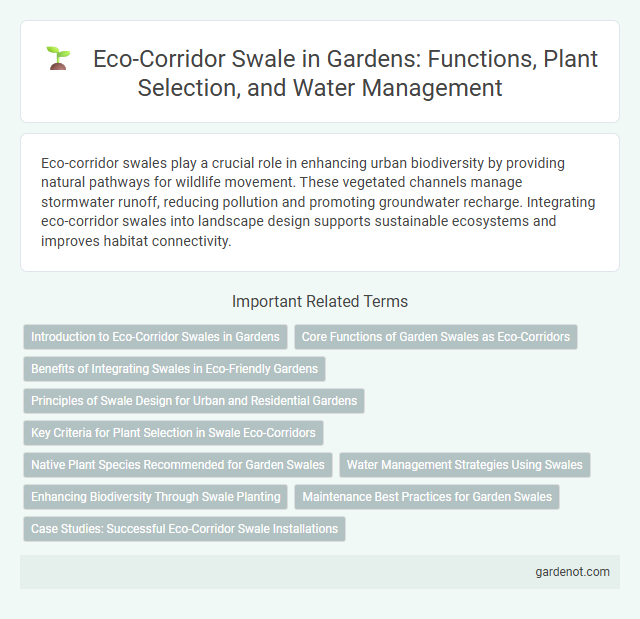Eco-corridor swales play a crucial role in enhancing urban biodiversity by providing natural pathways for wildlife movement. These vegetated channels manage stormwater runoff, reducing pollution and promoting groundwater recharge. Integrating eco-corridor swales into landscape design supports sustainable ecosystems and improves habitat connectivity.
Introduction to Eco-Corridor Swales in Gardens
Eco-corridor swales in gardens function as sustainable water management systems that capture and filter stormwater while supporting local biodiversity. These swales create interconnected green pathways that enhance habitat connectivity, promoting native flora and fauna. Incorporating eco-corridor swales improves soil health, reduces runoff pollution, and fosters resilient urban landscapes.
Core Functions of Garden Swales as Eco-Corridors
Garden swales function as eco-corridors by facilitating natural water filtration, enhancing groundwater recharge, and supporting biodiversity through connected habitats. These swales slow and capture runoff, reducing erosion and improving water quality while providing essential pathways for wildlife movement. Their design integrates vegetation and soil management to maintain ecological balance and promote sustainable urban drainage systems.
Benefits of Integrating Swales in Eco-Friendly Gardens
Integrating swales in eco-friendly gardens enhances rainwater management by capturing and slowly releasing runoff, reducing soil erosion and promoting groundwater recharge. These earth depressions support native vegetation growth, increasing biodiversity and creating natural habitats for pollinators and beneficial insects. Swales also improve soil health by facilitating nutrient retention and reducing the need for chemical fertilizers, contributing to sustainable and resilient garden ecosystems.
Principles of Swale Design for Urban and Residential Gardens
Eco-corridor swales integrate natural water management with urban green spaces by optimizing water flow, filtration, and soil absorption. Key principles of swale design for urban and residential gardens include maintaining gentle slopes between 1% to 5% for efficient water conveyance, incorporating native vegetation to enhance biodiversity and pollutant uptake, and ensuring adequate soil porosity for groundwater recharge. Proper sizing based on watershed area and rainfall intensity maximizes stormwater retention while minimizing erosion and waterlogging risks.
Key Criteria for Plant Selection in Swale Eco-Corridors
Key criteria for plant selection in swale eco-corridors include drought tolerance, deep root systems for effective water infiltration, and native species adapted to local soil and climate conditions. Plants must also support biodiversity by providing habitat and food for pollinators and wildlife. Selecting species with high pollutant uptake capabilities enhances water quality through phytoremediation in the swale system.
Native Plant Species Recommended for Garden Swales
Native plant species recommended for garden swales include Echinacea purpurea (purple coneflower), Carex spp. (sedges), and Asclepias tuberosa (butterfly milkweed), known for their deep root systems that stabilize soil and enhance water infiltration. These species thrive in moist, well-drained conditions typical of eco-corridor swales, supporting local biodiversity and providing habitat for pollinators. Incorporating native plants minimizes maintenance and reduces reliance on irrigation and fertilizers, promoting sustainable stormwater management.
Water Management Strategies Using Swales
Swales serve as efficient eco-corridors designed to manage stormwater through natural infiltration and filtration processes, reducing runoff and improving water quality. These linear, vegetated channels slow water flow, enabling sediment capture and nutrient absorption, which mitigates flooding and supports groundwater recharge. Implementing swale-based water management strategies enhances urban sustainability by promoting biodiversity and reducing reliance on conventional drainage systems.
Enhancing Biodiversity Through Swale Planting
Eco-corridor swales enhance biodiversity by supporting diverse native plant species that provide habitat and food for local wildlife. These vegetated swales improve ecological connectivity, allowing species movement and gene flow across fragmented landscapes. Swale planting also aids in water quality improvement, fostering a healthier ecosystem for aquatic and terrestrial organisms.
Maintenance Best Practices for Garden Swales
Effective maintenance of garden swales in eco-corridors involves regular inspection to prevent sediment buildup and ensure proper water flow. Vegetation management, including trimming native plants and controlling invasive species, promotes soil stability and enhances water filtration. Seasonal monitoring and debris removal optimize swale performance, supporting sustainable stormwater management and habitat connectivity.
Case Studies: Successful Eco-Corridor Swale Installations
Case studies of successful eco-corridor swale installations demonstrate significant improvements in urban stormwater management and biodiversity enhancement. In Melbourne, the implementation of green swales reduced surface runoff by 40% while increasing native vegetation cover by 25%. Similarly, Portland's eco-corridor swale project integrated permeable surfaces and wetland plants, achieving a 30% reduction in pollutants and creating wildlife habitats in densely populated areas.
Eco-corridor swale Infographic

 gardenot.com
gardenot.com